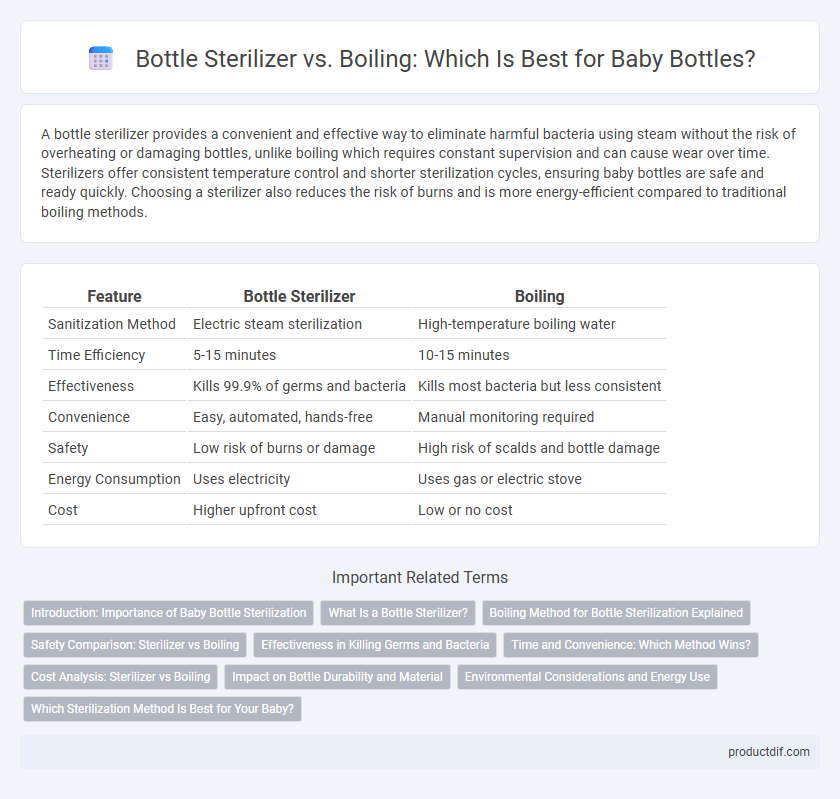A bottle sterilizer provides a convenient and effective way to eliminate harmful bacteria using steam without the risk of overheating or damaging bottles, unlike boiling which requires constant supervision and can cause wear over time. Sterilizers offer consistent temperature control and shorter sterilization cycles, ensuring baby bottles are safe and ready quickly. Choosing a sterilizer also reduces the risk of burns and is more energy-efficient compared to traditional boiling methods.
Table of Comparison
| Feature | Bottle Sterilizer | Boiling |
|---|---|---|
| Sanitization Method | Electric steam sterilization | High-temperature boiling water |
| Time Efficiency | 5-15 minutes | 10-15 minutes |
| Effectiveness | Kills 99.9% of germs and bacteria | Kills most bacteria but less consistent |
| Convenience | Easy, automated, hands-free | Manual monitoring required |
| Safety | Low risk of burns or damage | High risk of scalds and bottle damage |
| Energy Consumption | Uses electricity | Uses gas or electric stove |
| Cost | Higher upfront cost | Low or no cost |
Introduction: Importance of Baby Bottle Sterilization
Sterilizing baby bottles is essential to eliminate harmful bacteria and prevent infections in infants with developing immune systems. Using a bottle sterilizer offers a safer, more efficient method compared to traditional boiling, ensuring thorough disinfection without the risk of damaging bottles. This process promotes better hygiene, contributing to the overall health and well-being of newborns.
What Is a Bottle Sterilizer?
A bottle sterilizer is an electric device designed to eliminate harmful bacteria and germs from baby bottles using steam, ensuring thorough and efficient sterilization. Unlike traditional boiling, which requires heating bottles in boiling water for several minutes, bottle sterilizers provide a controlled environment with precise temperature regulation, reducing the risk of damage to bottles and accessories. These sterilizers often feature quick cycles and compact designs, making them convenient for busy parents seeking safe and hygienic feeding equipment.
Boiling Method for Bottle Sterilization Explained
Boiling method for bottle sterilization involves submerging baby bottles and accessories in boiling water for at least 5 minutes to effectively kill harmful bacteria and germs. This traditional technique is cost-effective, requires no special equipment, and is widely used by parents for its simplicity and reliability. However, boiling can sometimes damage bottles made from certain plastics or materials not designed to withstand high temperatures.
Safety Comparison: Sterilizer vs Boiling
Bottle sterilizers use controlled steam and high temperatures to effectively eliminate 99.9% of harmful bacteria, providing consistent safety for baby feeding equipment. Boiling water kills most germs but may not reach uniform temperatures throughout the bottle, risking incomplete sterilization. Sterilizers reduce the risk of burns and contamination compared to handling hot boiling water, offering a safer and more reliable method for maintaining infant health.
Effectiveness in Killing Germs and Bacteria
Bottle sterilizers use high-temperature steam or UV light to eliminate 99.9% of germs and bacteria, providing a more consistent and reliable sanitization compared to boiling. Boiling water kills most bacteria and viruses but often requires precise timing to ensure complete sterilization, with some resilient spores potentially surviving. Modern sterilizers also offer quicker cycles and reduce the risk of recontamination, making them more effective for maintaining hygiene in baby products.
Time and Convenience: Which Method Wins?
Bottle sterilizers sterilize multiple bottles simultaneously in as little as 6-15 minutes, offering a quick and hands-free solution for busy parents. Boiling requires 10-20 minutes per batch, plus time to heat water and cool down, demanding constant attention and effort. The convenience and efficiency of electric sterilizers make them the preferred choice for fast and reliable baby bottle hygiene.
Cost Analysis: Sterilizer vs Boiling
Bottle sterilizers typically involve an initial investment ranging from $30 to $70, offering convenience and consistent sterilization, while boiling requires no upfront cost but consumes energy and time with each use. Over time, the electricity usage of a sterilizer can amount to approximately $5 to $10 monthly, compared to the negligible ongoing cost of boiling water on a stove or kettle. Considering long-term efficiency and time savings, sterilizers may present better value for frequent use despite higher upfront costs.
Impact on Bottle Durability and Material
Bottle sterilizers use controlled steam or UV light to eliminate bacteria, preserving the integrity and longevity of plastic and glass baby bottles better than boiling, which can cause warping, discoloration, and degradation of materials over time. Prolonged exposure to boiling water can weaken seals and compromise the structural strength of silicone nipples and plastic components, leading to reduced safety and performance. Using a bottle sterilizer designed for baby products ensures effective sterilization while maintaining the durability and safety standards of various bottle materials.
Environmental Considerations and Energy Use
Bottle sterilizers use less water and energy compared to traditional boiling methods, making them a more eco-friendly choice for sanitizing baby bottles. Electric sterilizers often feature automatic timers and energy-efficient designs that minimize electricity consumption during the sterilization process. Boiling requires continuous heating of water on a stove, which typically leads to higher energy usage and increased carbon emissions, impacting environmental sustainability.
Which Sterilization Method Is Best for Your Baby?
Bottle sterilizers use controlled steam cycles to effectively eliminate 99.9% of harmful bacteria, offering convenience and consistent results compared to traditional boiling. Boiling requires immersion of bottles in rapidly boiling water for at least five minutes, which can be time-consuming and may degrade bottle materials over time. For busy parents seeking hassle-free, reliable sterilization that maintains bottle integrity, electric bottle sterilizers are generally the best choice.
Bottle sterilizer vs boiling Infographic

 productdif.com
productdif.com